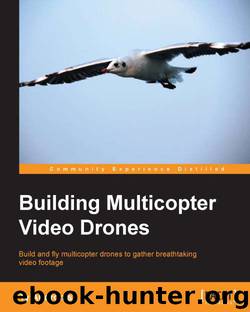Building Multicopter Video Drones by Ty Audronis

Author:Ty Audronis [Audronis, Ty]
Language: eng
Format: epub
Publisher: Packt Publishing
Published: 2014-08-25T21:00:00+00:00
Measuring your altitude
So we've got our position on the surface of the Earth, and we've got the direction we're pointed towards. Now we need our altitude. There are two ways of doing this. Well, really only one way on modern systems.
An older way of doing this was with sonar. On the AR Drone (version 1), there was a tiny speaker on the bottom of the multicopter, which sent out a clicking sound. A microphone on the bottom would measure the latency between the emitted sound and when the mic picked it up. Sounds ingenious, but how do you measure this above, say, 15 feet? Or what about on a sound-absorbing surface such as grass or carpet? Also, what about in a gym where sound can echo? This was inaccurate and lead to many mishaps.
The current method of measuring altitude is the same as your standard commercial airliner, using an altimeter that measures the barometric pressure (air pressure). As you travel up in altitude, air gets thinner. Believe it or not, even inches can make a tiny difference in the barometric pressure.
When controlling your multicopter, the throttle stick isn't really a throttle stick. Really, it's a vertical velocity stick. At 50 percent, your multicopter will hold its vertical vector at 0 percent velocity (a hover). Moving the stick up and down makes you ascend or descend. The more you move the stick, the faster or slower the vertical velocity is. The DJI Phantom 2 even has a spring-loaded throttle stick, so you can let go of both sticks, and the Phantom 2 will hold its position on all three vectors.
Needless to say, accuracy and speed are again important. A very sensitive barometer that samples data very fast will keep your multicopter from bobbing around in the sky.
Here's where the method of comparing the data is also very important. If you don't take your altitude into account when figuring out your GPS coordinates, you'll be in trouble. As you go up, you're moving closer to the space (and the GPS satellites). If you don't factor this into the equation to calculate your relative position to the map coordinates on the ground, the calculations will end up being inaccurate and conflicting. Sure, a 3D GPS fix can give you altitude ... but what if you lose GPS (say ... by going indoors). This may lead to instability. So, a guidance system that takes everything into account when figuring out what your multicopter is doing, and what to do to keep it stable, is crucial.
Download
This site does not store any files on its server. We only index and link to content provided by other sites. Please contact the content providers to delete copyright contents if any and email us, we'll remove relevant links or contents immediately.
| Color | Darkroom & Processing |
| Digital Editing | Equipment |
| Flash Photography | Handbooks & Manuals |
| Lighting | Reference |
Shoot Sexy by Ryan Armbrust(17171)
Portrait Mastery in Black & White: Learn the Signature Style of a Legendary Photographer by Tim Kelly(16513)
Adobe Camera Raw For Digital Photographers Only by Rob Sheppard(16423)
Photographically Speaking: A Deeper Look at Creating Stronger Images (Eva Spring's Library) by David duChemin(16184)
Bombshells: Glamour Girls of a Lifetime by Sullivan Steve(13154)
Art Nude Photography Explained: How to Photograph and Understand Great Art Nude Images by Simon Walden(12387)
Perfect Rhythm by Jae(4649)
Pillow Thoughts by Courtney Peppernell(3468)
The Book of Joy by Dalai Lama(3269)
Good by S. Walden(2939)
The Pixar Touch by David A. Price(2762)
Fantastic Beasts: The Crimes of Grindelwald by J. K. Rowling(2567)
A Dictionary of Sociology by Unknown(2534)
Humans of New York by Brandon Stanton(2394)
Read This If You Want to Take Great Photographs by Carroll Henry(2321)
Stacked Decks by The Rotenberg Collection(2304)
On Photography by Susan Sontag(2158)
Photographic Guide to the Birds of Indonesia by Strange Morten;(2106)
Insomniac City by Bill Hayes(2102)
